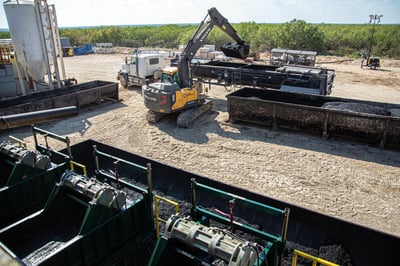 If you are looking for a way to remove open pits and reduce the associated liability from the drilling waste disposal process, moving to a closed-loop system is a great option to improve drilling cuttings waste management at the wellsite. With a closed-loop system, all cuttings are captured, processed, stored and discharged without open pits or containers. In place of an open pit, a closed-loop system uses sealed storage tanks and solids control equipment, including shale shakers and shaker screens, to remove excess solids and fluids from the drilling mud.
If you are looking for a way to remove open pits and reduce the associated liability from the drilling waste disposal process, moving to a closed-loop system is a great option to improve drilling cuttings waste management at the wellsite. With a closed-loop system, all cuttings are captured, processed, stored and discharged without open pits or containers. In place of an open pit, a closed-loop system uses sealed storage tanks and solids control equipment, including shale shakers and shaker screens, to remove excess solids and fluids from the drilling mud.
Determining the solids control plan and designing the best closed-loop system for the well go hand in hand. Haul-off and disposal become a critical part of the process since the oilfield trucking company must keep up with the solids and liquid waste captured by the closed-loop system.
The oilfield services equipment provider must be able to adapt if there is a change in the volume of solids or liquids being removed from the mud system during drilling. The oilfield trucking company must have the capacity to keep up with the haul-off and disposal volumes. Using a service provider who plans the trucking schedule ahead of time is what makes the closed-loop system so successful.
A closed-loop fluid waste management system can be used with any type of drilling fluid, (oil-based, water-based, brine or synthetic) with any type of rig and in any formation. In a previous blog post, we discussed the cost benefits and environmental factors that can drive operators towards a closed-loop drilling system. The closed-loop system is one component of a total drilling fluid management approach that can bring great benefits for the operator.
Environmental concerns are paramount in today’s drilling programs
In addition to environmental concerns, the traditional open pit system has many drawbacks. Before drilling, operators need to excavate the pits and create barrier berms. Then, expensive liner material is necessary to cover and seal the pit. At the end of the drilling phase, the process must be reversed. The liner (and all residual cuttings and fluid) needs to be removed and disposed of. The pit area must be graded to pre-drilling condition. And in many cases, the land must be returned to the original condition, with grass or trees planted to match the local environment. All of these steps are in addition to any environmental remediation required when a leak or spill occurs.
Haul-off and disposal
The last piece of a successful fluids management approach is cuttings and fluids haul-off and disposal. Panther contracts with trucking companies that provide fluid waste services using covered, sealed trailers that can safely transport the cuttings to the disposal site. These companies are fully vetted and licensed, employ experienced, qualified drivers and use safe and reliable equipment. We carefully plan the haul-off and disposal schedule before the job starts and our representatives are on hand to make sure everything stays on track. The company man and field personnel can take focus on drilling while Panther keeps the trucks moving.
Adhering to state and local regulatory controls has made closed-loop systems an attractive option for drilling operations. Closed-loop systems can minimize the risks associated with open pits by eliminating soil and groundwater contamination and removing the clean-up and remediation costs if spills or leaks occur. However, closed-loop systems can be complex. Having the right fluids company is critical to make sure the system is designed and executed properly.
Benefits of using a closed-loop system
A closed-loop drilling system can eliminate or dramatically reduce the use of open reserve pits. Additional benefits of a closed-loop system include operational, economic and environmental points.
Decreases the well footprint; no additional land needs to be purchased or leased for the large areas that open pits require
- Eliminates cost of pit construction and lining material
- Improves drilling economics by helping increase ROP and decreasing fluid loss
- Helps ensure regulatory compliance
- Contributes to the projects bottom line with reduced waste volume and waste disposal fees
- Decreases environmental issues by helping eliminate the risk of soil, surface water and groundwater contamination and associated remediation cost if leaks or spills occur
- Assuming that the storage tanks are the correct size at the onset of drilling, the tanks require little or no maintenance
- Tanks in the closed-loop system can be moved to a new site and reused once drilling is complete
- Once drilling is complete, there is no need for remediation of the open pits, which can include removing and disposing offsite of the waste materials and liner, burying the wastes and liner and backfilling the pit with soil
The Panther Advantage
Panther Fluids can design the best closed-loop system for your well. In conjunction with solids control equipment, Panther can safely and efficiently separate cuttings and fluid from the drilling mud, dispose of drill cuttings and fluids safely and efficiently and return the reconditioned mud to the drilling system. From designing the initial mud system to maintaining the right mud properties during drilling to safely transporting the cuttings to the disposal site, Panther has the experience and oilfield rental equipment to do the job right. Our total fluids management approach means we can take care of all fluids-related activities including the mud system, chemicals and additives, solids control and closed-loop systems and haul off and disposal. Panther takes care of the details so you can focus on drilling the well.

